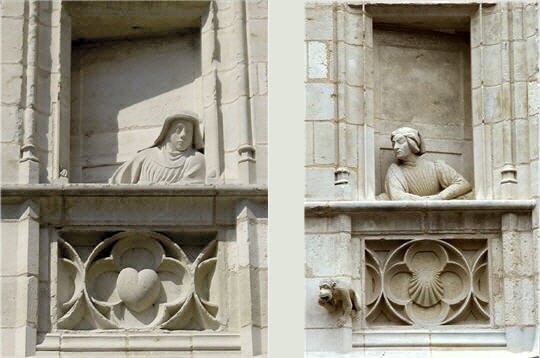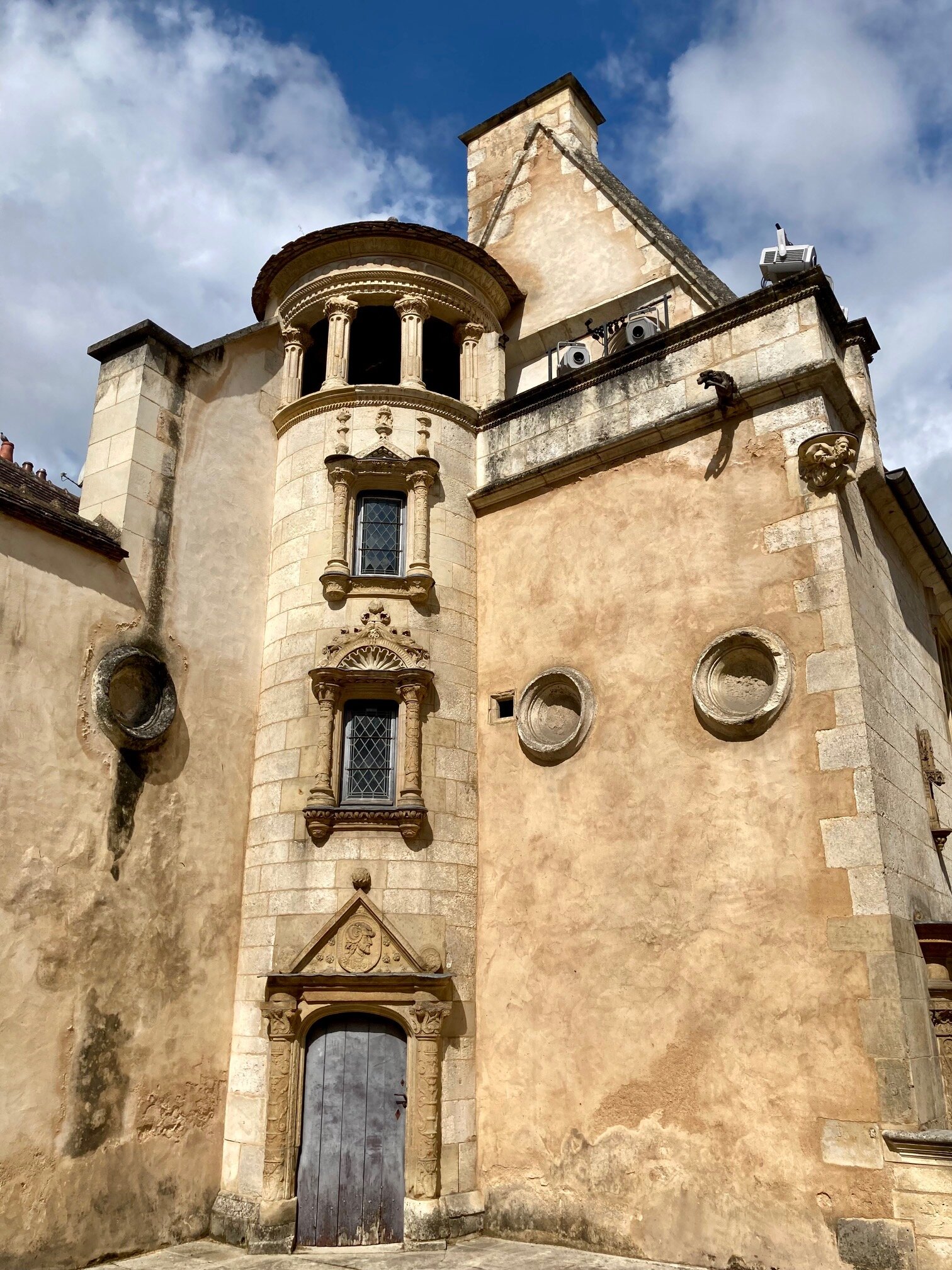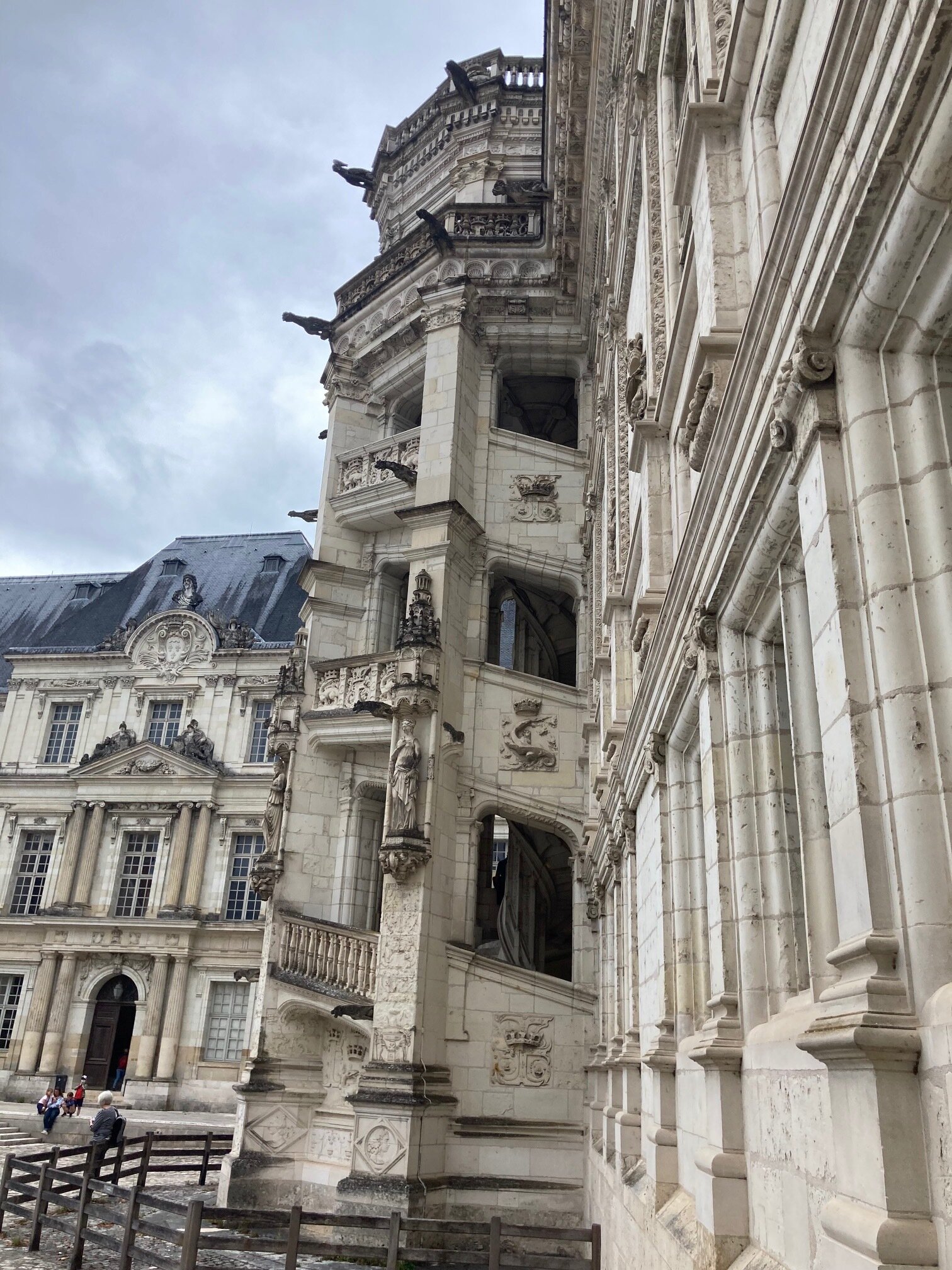Bourges et Blois
I have been driving back and forth from Paris to the Dordogne once a month for the past four, ever since we have been permitted to travel farther than 100 km from our homes. As soon as I get on the autoroute, I am distracted by the road signs. For places I’m not going. This last time, I could ignore the siren song of temptation no longer. Bourges and Blois beckoned. Alliteration, that’s my thing, too.
As soon as I began traveling to Europe with my husband, over 40 years ago now, we established a pattern that worked for us. We would pick a country to visit and along with our airline tickets and rental car, we would book a night or two at our port of entry. Whimsey determined the rest. Well, not exactly whimsy, but whatever road signs I recognized as we drove along. Which wasn’t as haphazard as it might seem. I was already in graduate school when I met my husband. Graduate school in art history. Monuments, Museums, Mansions. Images in my books. Imprinted in my mind.
BOURGES:
And that’s how we got to Bourges the first time, driving along the same highway 30 years ago, traveling from the Dordogne to Paris. As I read the road sign for Bourges that first time, two names popped into my head, the Duc de Berry and Jacques Coeur, the former of Très Riches Heures fame (which is at the Château de Chantilly and about which I have written). For the latter, an image of an enormous roof with lots of chimneys appeared. Yes, of course, the Palais du Jacques Coeur. (Figure 1)
Figure 1. Palais Jaques Coeur, Bourges, France.
I hadn’t been back to Bourges since then and I thought a return visit was in order. Last time, that first time, we stopped in Bourges and stayed in Blois. This time I decided to switch it up. The last time we had been in kind of a rush in Bourges, we had to get to Blois in time to find a hotel and visit the Chateau.
I didn’t want to rush Bourges this time. So, I booked the Hôtel de Bourbon and the history of Bourges began to unfold as we checked into the hotel, before we checked out the city. The hotel had been an abbey, built in the 17th century, built on the foundations of a 7th century church.(Figure 2) It was listed as an historical monument in the 1960s when the city of Bourges purchased it. But after a fire destroyed much of it, the city’s budget was insufficient to restore it. So it was sold to a hotel chain. Renovated, restored, transformed. It became a hotel in 1990.
Figure 2. Hõtel de Bourbon, Bourges, France
Which is one way to preserve an historically significant building. The Hotel de Crillion, you’ll remember, the twin of the Hotel de la Marine, was built in 1758, listed as an historic monument in 1900 and transformed into a grand hotel ten years later. But what was okay in Paris in 1900 wasn’t okay in Paris in 2000. Certainly not for the preservationists or anyone else who doesn’t appreciate their country’s patrimony sold to the highest bidder. Rule of thumb: commercial enterprises non, non-profit foundations, oui. Which is how the old Bourse de Commerce became a modern art museum, François Pinault’s money. The Hotel de la Marine escaped neither the highest bidder nor commercialization. The ruling family of Qatar, the Al Thani family contributed substantially to the restoration of the HdlM but the price of that money was giving the Al Thani’s art collection a permanent home there. As for commercialization, like the Monnaie de Paris (the former mint), the HdlM houses a Michelin starred restaurant. At Monnaie, it’s chef Guy Savoy, at HdlM, Jean-François Piège starts this September.
The Hotel de Bourbon in Bourges transformation was particularly well done. Our room was in the new wing. Bummer, right? Except that the wing is accessed through the restaurant. Which is the abbey’s towering chapel. (Figure 3) That was fun. When I expressed my appreciation for the hotel and its renovation to the receptionist, (as one does) she enthusiastically showed me a book that had been written about the hotel’s restoration.
Figure 3. Hôtel de Bourbon, Bourges, France
Since I had done my homework, I knew that the Musée du Berry was closed for renovations (too bad the budget hadn’t allowed for that to happen last year, when nobody would have noticed it was closed). But, I was there to see the Palais de Jacques Coeur and the Cathedral of Bourges, both of which were open, both of which were, as they say, worth the trip.
Figure 4. Jacques Coeur, statue in front of Palais de Jacques Coeur, Bourges
First stop was Palais de Jacques Coeur. Have you heard of Jacques Coeur? (Figure 4) He was Charles VII’s Fouquet. Let me explain. Jacques Coeur was born in Bourges, in 1395, the son of a wealthy wool merchant. Jacques took successful merchanting to another level, focusing on international trade, particularly with the Levant. His success led to King Charles VII making him master of the mint. Not a great job. Really a terrible job. Because at the time, there was no single currency in France and Coeur had to regularize the mess. And he didn’t make friends doing it. But he succeeded and in 1441, he and his family were ennobled. He chose a motto which incorporated his name A vaillans cuers riens impossible, "To a valiant heart, nothing is impossible". (Figure 5)
Figure 5. Interior, with JC’s motto. Palais de Jacques Coeur, Bourges, France
Coeur was at the height of his glory. He represented France at three embassies. He supplied the funding for the king's successful reconquest of Normandy. He held various offices of state. He owned so much and so many people owed him so much, including members of the royal family, it is only to be expected that the jealousy of others would be his undoing. And it was.
This is how it happened. In February 1450 Agnès Sorel, (Figure 6) the King's mistress died suddenly. Over a year later, rumors began to circulate that she had been poisoned. And then somebody, a lady at court who happened to owe Coeur money, accused him of poisoning her. No motive was established, nor any proof offered for this and other alleged crimes. But it didn’t matter. On July 31, 1451, King Charles VII gave orders for his arrest and for the seizure of his goods. The judges for the trial were chosen from among Cœur's enemies at court, aka, those who owed him money.
Figure 6. Agnes Sorel, (who bore King Charles VII only daughters) as the Virgin Mary, Jean Fouquet, 1450
He defended himself as best he could but the verdict was a foregone conclusion. His possessions were distributed among Charles VII's favorite courtiers, the largest amount kept by the king himself. Which was totally in character for the king who abandoned Joan of Arc. Unlike Joan who died on the stake, Coeur had friends in high places and he escaped to Rome where Pope Nicholas V welcomed him. The next year, 1456, on an expedition to Rhodes, Coeur became ill in Chios and died.
I mentioned that Jacques Coeur’s downfall reminded me of Nicolas Fouquet, Louis XIV minister of finance whose fete at his newly completely Chateau Vaux-le-Vicomte, (Figure 7) with gardens by Le Notre, made Louis XIV so jealous that the King confiscated all of Fouquet’s possessions and had Fouquet imprisoned for life. Coeur’s fall from grace two centuries earlier should have been a cautionary tale for Fouquet. And anyone else for that matter whose service to a king brings with it personal wealth as well as jealousy. The same thing happened in England to Thomas Cromwell, Henry VIII’s right hand man until he wasn’t. America’s own tacky version, Rudy Giuliani’s sad and disgraceful end, is being played out right now in real time on late night television and maybe Fox News, too, I don’t know.
Figure 7. Chateau Vaux-le-Vicomte, Le Vau & Le Notre, begun 1656
Although Coeur had properties all over France and beyond, the best preserved is in his own hometown of Bourges, the Palais Jacques Coeur. Coeur had it built right after he was ennobled. A residence to match his new rank, a residence that would be “beautiful, great and magnificent”. Construction began in 1443 and was completed nine years later, three years after Coeur was imprisoned.
The palace is grand without being heavy, playfully alive with delightful sculptural details everywhere, including Coeur’s two emblems, the hearts and the scallop shell, usually accompanied by his motto “a vaillan coeur, rien impossible.” (to the valiant heart, nothing is impossible). (Figure 8) The shell and heart are a reference his name, his first name, a scallop shell, a coquille St. Jacques, the emblem of pilgrims on the route de St. Jacques de Compostelle (Santiago de Compostela), and Coeur, a heart. Coeur’s palais marks a turning point in medieval architecture, when a chateau no longer had to be a châteaufort, a fortified chateau to protect its inhabitants but could be a palais where their pleasures, their comforts could be assured. Like for example, indoor plumbing and sous sol (under floor) heating. A feast room with a balcony for the musicians (Figure 9) and a chapel with beautiful stained glass windows.
Figure 8. Hearts & Shells decoration, exterior of Palais de Jacques Coeur, Bourges, France
Figure 9. Salle de Festins, Musicians Balcony, Palais de Jacques Coeur, Bourges, France
The palais is rich in sculptural details. Bas relieves purporting to be Coeur and his wife greet the visitor at the gateway. (Figure 10) Before his fall from grace, an equestrian statue of Charles VII adorned the façade of the mansion. The palm tree and date tree above the main entrance reference Coeur’s trading links to the Mediterranean, as do the ships carved about the doorway in the galley chamber. Carved wooden faces adorn the ceiling of one room, a stone sculpture of Tristan and Isolde, (Figure 11) the fireplace of another. Couples playing card and board games, greet visitors above a fireplace in a hallway. (Figure 12)
Figure 10. Jacques Coeur and his wife, exterior, Palais de Jacques Coeur, Bourges, France
Figure 11. Tristan and Isolde meeting (with King Mark hiding behind a tree) interior, Palais de Jacques Coeur
Figure 12. Card and board playing couples, interior Palais de Jacques Coeur, Bourges, France
In 1451 when Jacques Coeur was arrested, the house was confiscated but since nobody could be found to buy it and I guess because maintaining it was too expensive, it was returned to Coeur’s family in 1457. The house passed from one private owner to another until 1679 when its final private owner, Jean-Baptiste Colbert, Louis XIV’s minister of state, the instigator of Fouquet’s downfall, sold it to the city of Bourges. Which, of course, made a mess of it, chopping up rooms, tearing down chimneys, destroying sculptures as its purpose changed from town hall to court house. That all ended in 1840 when the Palais Jacques Cœur was listed as a historical monument. The Centre des Monuments Nationaux manages it now.
Figure 13. Bourges Cathedral, begun in 1195, Bourges, France
The second formidable edifice in Bourges is its Cathedral. (Figure 13) It has been declared a UNESCO World Heritage Site twice; once on its own account and once again as a stop on the pilgrimage route to Santiago de Compostela. The cathedral, built atop an earlier Romanesque church, is largely in the High Gothic style, constructed at about the same time as Chartres. Like Notre Dame in Paris, the wooden framework for the roof required the wood from nearly 1000 oak trees. The fire which caused serious damage to Bourges Cathedral happened in 1259, 750 years before the same fate befell Notre Dame. Because of stability problems, towers kept falling down at Bourges Cathedral, the new front and the towers are reinforced by massive buttresses. (Figure 14)
Figure 14. The more delicate buttressing of Bourges Cathedral, Bourges, France
The sculptural program is very rich. The sculpture over the central portal, as convention dictates, illustrates scenes from the Last Judgement. (Figure 15) Christ, at the top of the tympanum, divides the sinners from the saved. One arm up, one arm down. The archangel St. Michael below, weighs the souls. Sometimes the souls of the damned are heavier, sometimes, like at Bourges, the souls of the saved, are. As usual, the fates of the sinners are a lot more interesting to observe.(Figure 16) I mean maybe leading a pious life and then standing around singing hymns for all eternity is the better move, (Figure 19) but for an observer, the only porn-art available at the time to most church going Europeans was the naked writhing bodies and kinky devilish activities which befell the damned in Hell. The garden surrounding the Cathedral is beautiful and was a pleasure to stroll around, even as we avoided the raindrops and downpours.
Figure 15. Tympanum, Central Portral, Last Judgement, Bourges Cathedral, Bourges
Figure 16. Detail of Last Judgement. Sinners and Punishment on right, Bourges Cathedral, Bourges, France
The next day, after an easy breakfast in the hotel’s soaring chapel restaurant, we strolled around the medieval ‘pedestrianized’ old town with its half timbered houses (Figure 17) on our way to the Hotel de Lallemant. (Figure 18) Built at the beginning of the 16th century, just a few years before the Loire châteaux, its facades are adorned with antique decorations which suggest that Italian artists were here. Like the Palais de Jacques Coeur, but on a smaller scale, sculptural decorations abound. (Figure 19) In one room, there was a lovely fireplace embellished with the emblem of Louis XII, the porcupine and that of Anne of Bretagne, the ermine. (Figure 20) Both of which were seen in profusion at our next and final stop, the nearby Chateau de Blois, (Figure 21) a 90 minute drive from Bourges.
Figure 17. Half timbered house in Bourges, France
Figure 18. Hotel de Lallemant, 1500, Bourges, France
Figure 19. Sculptural decoration, Hotel de Lallemant, Bourges, France
Figure 20. Emblem of Anne of Bretagne & Louis XII, Hotel de Lallemant, Bourges, France
CHATEAU DE BLOIS
Figure 21. Chateau de Blois, begun 1100, Blois, France
The chateau is enormous but the gardens, which at other chateaux are such an essential part of the visit, are long gone, gobbled up by an expanding city. But Blois is a wonderful way to learn something about French royal history and architectural history and historic preservation, too.
An equestrian statue of Louis XII on the exterior facade greets visitors. (Figure 22) Below Louis is his symbol, the crowned porcupine. On either side of the porcupine, the initial L for Louis and A for Anne, Anne of Bretagne Louis’ wife. That’s an interesting story. She was originally married to his cousin, Charles VIII (the king whose death without heir led to Louis becoming king). Once Louis ascended to the throne, he wisely annulled his own childless marriage to marry Anne, for the same reason his dead cousin had, her dowry, the duchy of Brittany. So that’s how that happened.
Figure 22. Equestrian Statue of Louis XII, exterior, Chateau de Blois
Once you’ve gone through the security check, had your vaccination status QR code scanned and paid the entry fee, you arrive in the courtyard where the star attraction is the staircase built during the reign of Francois I. (Figure 23) You remember him, the king who invited Leonardo to to live in France. Francois’ royal symbol, the fire-breathing salamander, is at the base of this staircase in what is called the Francois I wing built in the French Renaissance style, by the Italian architects and decorators Francois employed here and most noticeably at Fontainebleau, about which I have already written.
Figure 23. Staircase of Francois I, Chateau de Blois, Blois, France
And then, having nothing to do with the architecture but everything to do with history is the fact that Henri III, son of Catherine de Medici, had one of the most vociferously anti-Protestant reactionary Catholics in the realm, the Duc de Guise, assassinated at Blois in 1588. (Figure 24) The Duke’s brother, the Cardinal de Guise, an equally vociferous Huguenots hater, met the same fate, next day, same place.
Figure 24. Assassination of the Duke de Guise, Chateau de Blois, 1588 (1934)
After the French Revolution, like so many grand and especially royal structures, it was abused then neglected and finally modified to fulfill a variety of roles and each new role required the destruction of one thing or another. In 1840, that was over and Blois was among the earliest royal structures to be designated an historical monument. And when the restorers arrived, they came with their own ideas and opinions.
A room in the Chateau de Blois explores its restoration, especially Félix Duban, the architect who was responsible for it from 1843 until his death in 1870. Restoration is always fraught, no matter what is being restored. For a structure as old as Blois, with so many layers superimposed upon each other, the question of what moment in history to restore is crucial. The oldest part? The most beautiful parts? The politically / historically significant parts? And every generation has a different notion of restoration - what amount of license can be taken, should be allowed. Chateau de Blois has a lot to offer. Find a guide or get an audio guide, it will help you make sense of as much of it as you want to know about. I’m glad I finally got back and since it’s only 2 hours from Paris by car or train, I hope you get there, too. And soon.
Copyright © 2021 Beverly Held, Ph.D. All rights reserved
Dear Reader, I hope you enjoyed reading this article. Please click here or sign up below to receive more articles plus other original content from me, Dr. B. Merci!
And, if you enjoyed reading this review, please consider writing a comment. Thank you
























